Advantages and Disadvantages of Satellite Communication
We occasionally see some intriguing lights travelling gradually and in a linear fashion through the night sky without blinking or sparkling. It could be a satellite. There are many distinct sorts of satellites that orbit or travel around a planet or star. The moon is an innate example of a satellite in view of the fact that it spins around the Earth. However, in most instances, when individuals refer to satellites, they refer to manufactured objects sent into orbit.
Satellites orbit the Earth like spacecraft and are typically equipped with a computer and solar panels that draw power from the Sun. In 1957, a satellite was launched into orbit for the first time. It was named as Sputnik and was roughly the size of a ball. Tons of satellites are currently present in the sky. They occasionally also have cameras or other research gear to aid data collection.
Let's examine in greater detail what satellite communication is, how they operate, what they are employed for, and their benefits and drawbacks in this post.
Satellite Communication System
What is a Satellite?
Any entity that orbits a planet in a curved route is considered a satellite. Another way to think of a satellite is as a tiny object in space that orbits a bigger one.
Classification of Satellites
When it comes to categorizing satellites, there are two main categories:
- Natural Satellite
Natural satellites are natural objects that orbit other, larger natural objects in space. For instance, the moon of the Earth is a natural satellite, as are the planets which orbit the Sun. It moves in a predetermined orbit around the Sun.
- Artificial Satellite
Artificial satellites are created by humans and put into motion employing rockets.
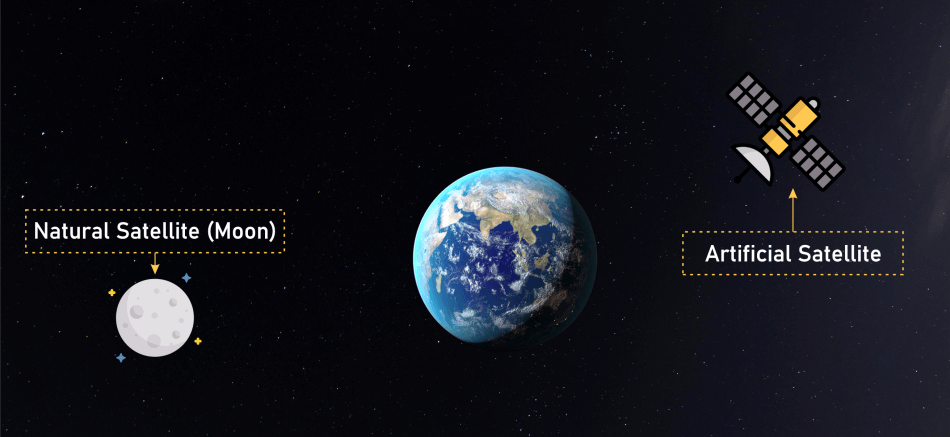
What is Communication?
Disseminating data between two or more entities via any stream or channel is communication.
What is Satellite Communication?
Satellite communication is the term that encompasses any communication that incorporates different ground stations and a satellite.
Need for Satellite Communication
- Ground wave propagation and sky wave transmission were the two techniques of propagation traditionally used for telecommunication.
- The combined distance that the two of them can travel is 1500 kilometres.
- This restriction is addressed through satellite communication. Longer-distance communication can be accomplished with it, even beyond the line of sight.
- In 1945, renowned British science fiction author Arthur C. Clarke came to believe in satellite communication.
- The function of satellites is specifically for communication.
Understanding Satellite Communication
- We notice that the general communication process is split into two portions, with the uplink being the portion of the process when information is transferred to the satellite.
- The second phase, known as downlink, occurs while the satellite is retransmitting and another earth station intercepts the data or signal.
- The data is streamed at a distinctive frequency from the frequency at which it is retrieved at the earth station.
- Information is sent over the uplink at frequency f1 and received over the downlink at frequency f2.
- f1 and f2 are not equal.
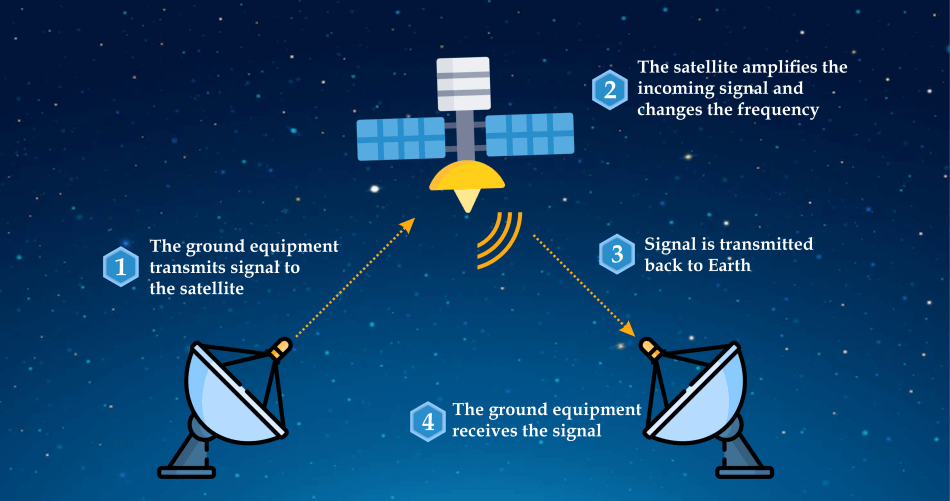
Satellite Communication Components
- The following are the two fundamental satellite communication system segments:
- Ground section:
- It consists of the following items: the earth station, user terminals and interface, broadcast and receive devices, and antenna systems.
- Space section:
- It consists of a launch vehicle, a satellite, a communication transponder, a communication antenna, and an electrical power system.
- There will be a satellite, two earth stations (earth stations 1 and 2), and other equipment.
- With the help of a high-directional dish antenna, an earth station transmits information to the satellite.
- The uplink, or transmission of data to the satellite, is being made by earth station 1.
- Earth Station 2 (sometimes referred to as the downlink) receives data from the satellite.
- The uplink frequency is the frequency at which data is broadcast, while the downlink frequency is the frequency at which earth station 2 gathers input from the satellite.
- Typically, the uplink frequency and the downlink frequency are maintained separately.
- The satellite transponder changes this signal to a different frequency and is transmitted to earth station 2.
- Transponders are the engines of communication satellites.
- The transponder's primary duties include changing the frequency of the input signals, eliminating sound output, and increasing the transmission quality.
- The transponder requires a significant amount of electrical energy to accomplish these tasks.
- The satellites can use batteries or solar panels to deliver electricity.
- A solar panel fuels the electronic devices, but batteries are employed during the eclipse.
- A sun sensor is also seen on the satellite. The photovoltaic cells may be oriented correctly to capture the most energy from the Sun with the aid of these sun detectors.
- Reflector antennas constitute the most prominent type of antenna mounted to satellites.
- A satellite is contemplated to advance in the direction of its designated orbit.
- The gravitational field surrounding the satellite is not consistent because of the uneven mass distribution of the planet, as well as the influence of the moon and the Sun.
- As a result, the satellite may occasionally be knocked off its orbital position.
- The result of this is a total signal loss.
- Satellites employ thrusters to avoid these scenarios.
- The satellite is kept in the proper position by the thrusters.
- The reservoirs in the satellite housing store the fuel required for the thrusters.
- An earth station routinely helps to keep track of the satellite's location.
- The earth station also assesses the condition and pace of the satellites.
Satellite Orbits
An orbit is a periodic, repetitive trajectory that an entity in space takes to round another entity.
Classification of Satellite Orbits
1. According to inclination
- Equatorial orbit:
- An equatorial orbit is one in which the satellite travels along a trajectory that is primarily spherical and revolves just above the equator.
- It has a zero-degree inclination.
- Inclined orbit:
- All trajectories are tilted, excluding those that pass directly over the Northern and Southern hemispheres or the centre.
- The inclination angle ranges from zero to 180 degrees.
- Polar orbit:
- A polar orbit emerges when a satellite spins in an orbital arrangement perpendicular to the equatorial plane and crosses both the North and South poles.
- Polar-orbiting satellites go over and very close to the North and South poles on a low-altitude path close to the earth's surface.
- A spacecraft in a polar orbit is inclined at a nearly 90-degree angle.
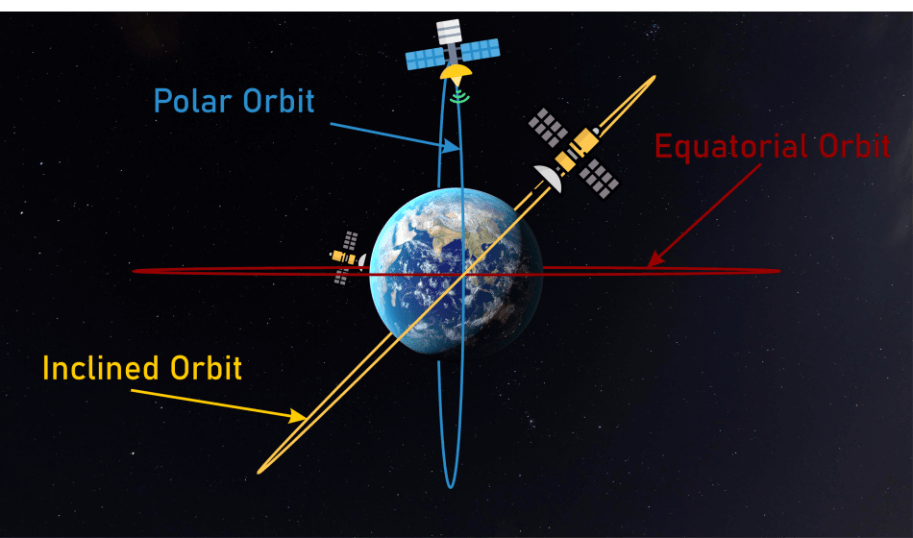
2. According to distance from Earth
- Low Earth orbit:
- These satellites orbit between 160 and 2000 kilometres above the planet's surface.
- The Earth's orbit completes in 90 to 120 minutes.
- Medium Earth orbit:
- It refers to the space surrounding the Earth, above the geostationary orbit, and underneath the low earth orbit.
- A medium earth orbit satellite's orbital period might be between two and six hours.
- This satellite orbits the Earth between 2000 and 35,786 kilometres beyond the surface.
- Geosynchronous orbit:
- An Earth-orbiting satellite is referred to as geostationary.
- It is positioned immediately over the equator at about 35,786 kilometres.
- It rotates in the exact orientation of the Earth's rotational axis, west to east.
- The orbit of this spacecraft around the planet takes 24 hours.
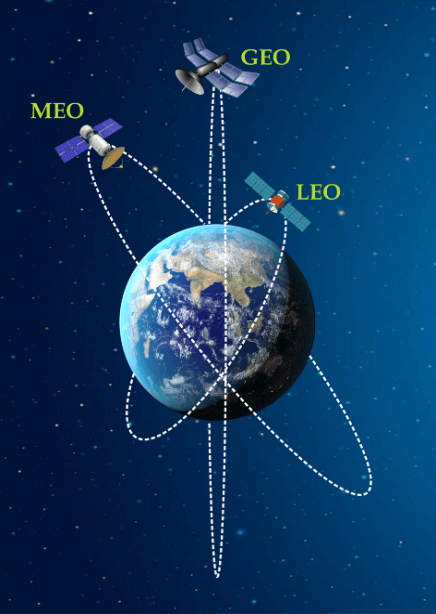
3. According to its shape
- Spherical orbit:
- The circle-shaped trajectory revolves at a given distance from the barycentre.
- The eccentricity of this orbit is 0.
- Different kinds of circular orbits exist. They consist of the following:
- Geosynchronous orbit
- Polar orbit
- Equatorial sphere
- Elliptical orbit:
- An elliptical orbit is the movement of one object around another along a route with an oval shape.
- The orbits with an eccentricity higher than 0 but much less than 1.
- These satellites are occasionally closer to the Earth and occasionally farther away.
- A satellite's perigee is the point at which it approaches nearest to Earth.
- The Apogee is the furthest location.
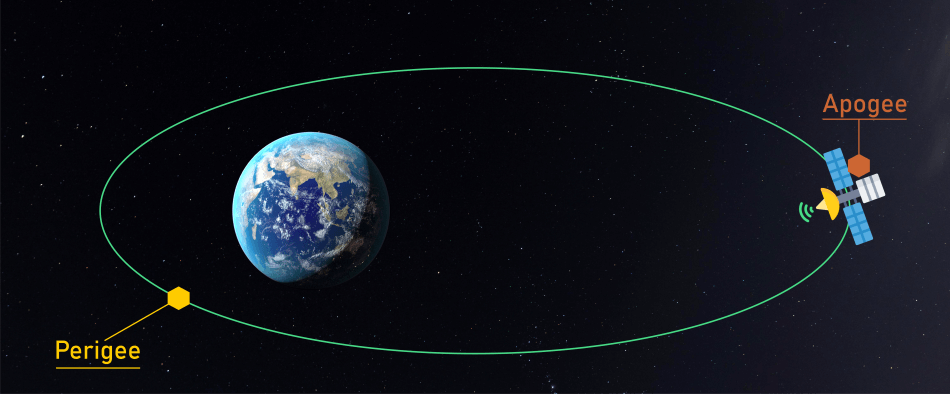
Choosing the Satellite Orbits
- It is a well-known fact that the satellite stays in orbit because of the balance between gravitational pull and centrifugal force.
- The angular velocity of the satellite is decided by the force balance equation that balances the gravitational and centrifugal forces.
- When the satellite is deployed, it is given sufficient speed to balance these two forces.
- A satellite near to earth requires more speed to resist the gravitational pull than the ones located further from the earth.
- Due to the negligible resistance in space, satellites never loose speed. This means satellites will continue their circular motion around the earth without any external energy source.
- Satellites are places either in low earth orbit, medium earth orbit or geo-synchronous orbit.
- The decision on what orbit is to be chosen for placing the satellites will depend on the application and purpose of the satellite.
- If it is built for earth observation like weather forecasting, geographic area surveying, satellite phone calls etc, then orbits closer to the earth are chosen.
- Low earth orbit is the closest to the earth and hence is chosen for these applications.
- But these types of satellite cover very less area and hence more satellites are required to provide a better coverage.
- In case of broadcasting, a high orbit such as geo-synchronous orbit are chosen.
- For navigation application such as GPS, Medium earth orbits are the wise option.
Other Artificial Satellite Types
1. Navigation Satellites
- The location of an entity on the surface is identified via a satellite navigation system.
- It establishes the precise position of any object, including warships, planes, and other vehicles.
- Military forces also need it to function.
- It is frequently employed as a military tool or to acquire data for military reasons.
- The following are the main satellite navigation systems: The Global Navigation Satellite System is the name of the global navigational system (GNSS)
- The United States first introduced the Global Positioning System, or GPS, satellite technology.
2. Weather Satellites
- The main purposes of the weather satellite are:
- To keep an eye on earth's environment and weather.
- The ability to forecast everyday meteorological conditions like temperature and rainfall.
- To keep track of the growth and evolution of meteorological phenomena such as storms, hurricanes, cyclones, and tropical storms.
3. Communication Satellites
- A communication satellite is a spacecraft that sends signals across vast distances, including phone, television, radio, and internet transmissions.
Launching an Artificial Satellite
A satellite is placed into orbit by a two-step process:
- The satellite must first be elevated to the required altitude before launching at the proper velocity to start and maintain its orbit.
- A launch vehicle (such as a rocket or a space shuttle) is used to place a satellite in orbit around the planet.
- A multistage rocket serves as a satellite launch vehicle.
- Additionally, it has several smaller booster rockets.
- During take-off and the initial stages of flight, the boosters propel the rocket with its initial thrust.
- The rocket disintegrates, and the other boosters take over as the fuel in the boosters runs out.
- Only the initial seconds of a launch vehicle's flight are spent flying straight up.
- The vehicle becomes lighter and can move faster as each booster is released. It releases the satellite into orbit once it has attained the required altitude and speed.
Advantages of Satellite Communication
- The connection between many points is conceivable.
- Greater connectivity than terrestrial systems.
- It is simple to demonstrate satellite networks.
- This circuitry has great resistance.
- Every region of the earth can be accessed via satellite communication.
- The expense of a satellite is independent of distance.
- Irrespective of the distance, information may be transmitted and collected.
- Increased broadcasting capabilities and bandwidth.
- Communication is possible around-the-clock.
Satellite Communication Drawbacks
- Start-up costs are significant.
- Frequency congestion is a possibility.
- Problems with transmission and distortion could occur.
- The process of placing a satellite into orbit is expensive.
- Satellite systems have a longer propagation delay than typical terrestrial systems.
- The effectiveness of the satellites in transmitting information is decreased by significant delay.
- Challenging to rectify if a satellite system encounters any issues.
- High-strength and large-diameter transmitters are needed for satellite communication transmitters and receivers.
- The effectiveness of the satellite component declines as a result of aging.
- More free space loss.
Applications of Satellite Communication
- Streaming on radio
- Telecasting services like Direct to Home (DTH)
- Internet-based tools like GPS military tools
- Navigations
- Remote sensing software
- Earth observation
- Observing and predicting the weather
|
 For Videos Join Our Youtube Channel: Join Now
For Videos Join Our Youtube Channel: Join Now















